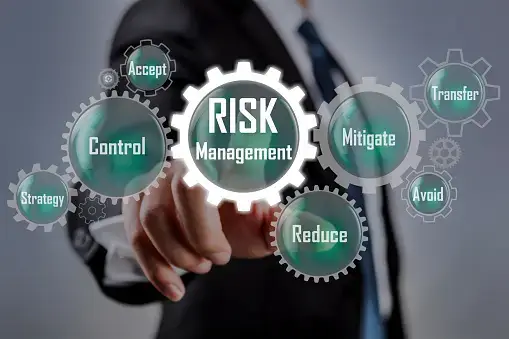
In today’s globalized economy, SCRM is critical for businesses eager to expand or grow their reach into emerging markets. Africa is the fastest-growing economy, which makes supply chain risk management in Africa a must-have for businesses and supply chains alike.
Effective supply chain management requires a proactive approach to risk management, where businesses must anticipate and mitigate potential risks before they occur.
Introduction
Africa is home to one of the fastest-rising economies in the world today. Subsequently, supply chain management on the continent has experienced exponential growth, making it increasingly complex to navigate. Despite all this, legitimate concerns exist about the risk associated with any given supply chain.
Some of these risks are political uncertainties, economic fluctuations, and environmental issues. The good news, though, is that despite these risks, there are strategies that can mitigate them and ensure more businesses enjoy successful supply chain management all through Africa.
We will explore the risks associated with supply chains on the continent and practical strategies to mitigate them. We will also review the importance, future trends, and examples of successful supply chain risk management in Africa. Keep reading to gain new insights into supply chain management risks.
What is Supply Chain Risk?
Supply chain risks are possible (internal and external) factors that can interrupt the flow of goods and services across the supply chain. These factors may come in varying degrees. You will have complete power, and you will have zero control over some.
Supply chain risks can be theft or loss of products, supplier failures, unfavourable government policies, natural disasters, pandemics, and political instabilities. They may occur anywhere across the supply chain, from raw material acquisition to production, storage, distribution, and delivery to the customer.
Risks Associated with Supply Chain Management in Africa
Supply chains across Africa face unique challenges and risks due to several factors. For starters, the sheer size and diversity of the continent’s business landscape entail a lot of stakeholders, which only complicates the supply chain process.
To effectively run your supply chain on the continent, you must be aware of these risks to develop effective mitigating strategies.
1. Infrastructure limitations
Africa is still plagued with poor infrastructure across most of its regions. According to this Africa’s Development Index article, only a few countries are above the 50 points mark. It is not a good sign for businesses hoping to run effective and successful supply chains.
The Poor infrastructure impacts areas like logistics, production, and warehousing and inevitably leads to increased costs, disruptions, and potential downtime in the supply chain.
To get around this effectively, you must plan for infrastructure challenges, such as unreliable power supply, limited road connectivity, and insufficient storage capacities, to minimize their impact on the supply chain.
2. Political and regulatory uncertainties
The political landscape in African regions can be volatile and tedious for businesses and their supply chains. With frequent policy changes, regulations and trade agreements have only tightened, effectively hobbling supply chains.
This is because every policy and regulation directly impacts supply chains. For example, closing the Nigerina land border impacted supply chain operations, including customs procedures, import/export restrictions, and lead times throughout the country.
The easiest way to mitigate supply chain risks associated with policy changes is by staying updated with the political and regulatory policies while building strong relationships with local authorities.
3. Security and theft
The security challenge is another risk businesses must consider when planning their supply chains. Criminal activities such as theft, piracy, and sometimes civil unrest are prevalent in many African regions and can cause extensive damage to any supply chain.
Failure to properly tackle these risks can result in supply chain disruptions, loss of inventory and equipment, and even cause potential harm to the safety of your supply chain staff. News of kidnapped staff or stolen properties are not a new phenomenon.
The security issue is a problem, but it is far from unfixable. Governments across the continent should take the initiative in this. After all, a secure country or environment would boost economic investment. Businesses can implement robust security measures such as secure storage facilities, tracking tech, and comprehensive risk assessments.
4. Supplier reliability
Africa is vast and diverse, with most businesses enjoying a friendly environment for their operations to thrive. However, finding a reliable supplier who shares your vision amid such diversification of ideologies can take time and effort. This is especially the situation in remote areas or industries with limited competition.
Sometimes, the suppliers might not necessarily be at fault. They still have to navigate the African terrain riddled with poor security and infrastructure. Failures from suppliers can end up impacting your business or supply chain negatively.
The key here is to engage with multiple suppliers. Depending on a single supplier or working with limited supplier options can expose your supply chain to disruptions and increase the risk of quality issues.
Always ensure you conduct thorough supplier assessments, establish strong backup options, and foster really good relationships with trusted suppliers to minimize these risks.
5. Demand volatility
Like the rest of the world markets, demand in Africa can be very volatile. Bad publicity, regression variations, and economic fluctuations can lead to demand volatility. African markets are no exception.
The market’s demand volatility emphasizes the importance of building a strong and reliable demand planning and forecasting system for your supply chain management. Poor accuracy in demand forecasting will lead to poor planning, which leaves your supply chain in a world of trouble.
To better control this, invest in the right demand forecasting and planning system; you can read this article for more insight on that.
6. Cultural and language differences
This challenge is easily navigated if you are born and raised in Africa and now conducting business on the continent. However, for foreigners or foreign businesses, it is very important if you want to enjoy successful supply chain management.
Africa is diverse, with so many languages that it might take you or me 24 hours to completely list them. This can prove challenging, especially if your business is in a remote region.
To get ahead of this, your supply chain can invest in cultural intelligence, employ local talent, and foster cross-cultural collaboration to navigate these challenges and build strong relationships with customers, suppliers, and partners.
7. Economic instability
Economic instability is another challenge to supply chains. Imagine buying your raw materials at $100, and by the time it goes through your supply chain and out to the consumer, the same raw material might have doubled, even when you are selling to your consumers, using the initial cost.
It can be quite frustrating doing business in such an economically unstable environment. However, there is good news. Many other countries and economies are doing very well on the continent, so you can relocate your business there or develop a robust risk strategy that plans with the economic situation in mind.
Tip: Your system or strategy should account for inflation, currency fluctuations, and financial crises.
================================================
If you wish to run a successful supply chain management in Africa, you will need to understand the risks and challenges unique to the region. Proactively identify and address these risks, and you are off to enjoy seamless supply chain management.
Benefits of Mitigating Supply Chain Management Risks in Africa
You cannot overstate the importance of risk management for any supply chain. For your supply chain to enjoy success, you must actively engage and mitigate the challenges mentioned earlier.
Here are some more reasons to mitigate supply chain risks.
Mitigating vulnerabilities
There are quite a number of vulnerabilities in doing business or running a supply chain in Africa. Setting up an effective risk management strategy will identify and tackle or set up work around these challenges. This allows your supply chain to ensure continuity and minimize disruptions.
Ensuring product quality and safety
When you proactively handle your supply chain’s risk management, you can ensure the quality of your product. How? By identifying and controlling all risks related to the sourcing and producing of goods and services. Depending on the nature of the supply chain, it might also entail logistics and delivery.
Managing supplier reliability
Managing your suppliers effectively is a big part of the supply chain. There are a lot of unreliable suppliers, so it is on you and your supply chain to serve them out effectively. This can be facilitated during the selection process or by adopting a “test and see” approach.
With supply chain risk management, you can assess and manage the risks associated with supplier performance, including delays, quality issues, financial stability, and capacity constraints. It enables businesses to maintain reliable and sustainable supplier relationships.
Enhancing resilience
In a competitive environment, a resilient supply chain is a reliable tool to get ahead. Africa’s geographical, political, and economic landscape can be quite unpredictable. A well-thought-out supply chain risk management builds resilience by developing contingency plans, diversifying suppliers, establishing alternative transportation routes, and ensuring redundancy in critical processes.
All this ensures supply chain continuity in the face of potentially impactful or disruptive incidents.
Optimizing cost efficiency
Well-established and effective risk management improves overall supply chain performance and, by nature, cost-effectiveness. Optimized cost efficiency is a good side effect of an effective risk management strategy.
This includes reducing the expenses associated with disruptions, such as inventory shortages, production delays, and transportation bottlenecks.
Meeting customer expectations
With competition and continued technological advancement, customer expectations are through the roof. This is also true in Africa.
African customers have seen better and increasingly have high expectations for product availability, timely delivery, and quality. You can blame them; other businesses and supply chains are also doing this.
Supply chain risk management is your answer, and it will be crucial in meeting these expectations by ensuring a reliable and efficient supply chain. Risk management helps businesses maintain customer satisfaction, loyalty, and competitive advantage.
Compliance with Regulatory Requirements
Africa is one of the most regulated places in the world, although a lot of these regulations impede rather than help businesses and supply chains.
Countries have unique regulatory frameworks, trade agreements, and customs procedures. Effective supply chain risk management ensures compliance with these requirements, minimizing legal and regulatory risks. It helps your supply chain avoid penalties, reputational damage, and potential market access issues.
Enhancing Stakeholder Confidence
Demonstrating effective supply chain risk management practices enhances stakeholder confidence. This includes investors, partners, customers, and regulatory authorities.
Strategies for Mitigating Supply Chain Risk Management in Africa
Diversify Supplier Base
Over and over again, relying on a single supplier increases the risk of disruptions. By diversifying your supplier base, your business can spread that risk and have alternative options in case of supplier-related issues.
Conduct Risk Assessments
Regularly assess potential risks in your supply chain, such as geopolitical, economic, environmental, or operational risks. Identifying critical points and vulnerabilities will prioritize risk mitigation efforts.
Implement Supply Chain Visibility
Supply chain visibility helps you stay on top of your operations. You can enhance visibility across the supply chain by leveraging technologies like IoT, RFID, and data analytics. Real-time monitoring of facets of the supply chain, including inventory, transportation, and production processes, allows for proactive risk management and quick response to disruptions.
Establish Contingency Plans
Develop smart contingency plans for potential supply chain disruptions, such as natural disasters, political unrest, or supplier bankruptcies. Having backup suppliers, a few redundant inventories, and alternate transportation routes can help minimize the impact of any disruption to your supply chain.
Enhance Communication and Collaboration
Effective communication and collaboration among stakeholders, including suppliers, partners, and customers, are vital. Sharing information, insights, and forecasts can help anticipate risks and coordinate responses.
Invest in Technology
Embrace technology solutions that enable automation in your supply chain. Predictive analytics and real-time data sharing are examples of these solutions. This allows for better risk assessment, faster decision-making, and improved supply chain resilience.
Ensure Regulatory Compliance
Stay up-to-date and implement regulations and compliance requirements in the regions where your supply chain operates. Non-compliance can result in legal issues, disruptions, and reputational damage to your supply chain.
Build Resilience
Strengthen the supply chain’s resilience by implementing buffer stock, redundancy, and flexible manufacturing strategies. This helps absorb shocks and maintain operations during unforeseen events.
Continuously Monitor and Adapt
Supply chain risks are dynamic and ever-evolving. Regularly monitor the supply chain, assess risks, and adapt strategies accordingly. Embrace a culture of continuous improvement to stay ahead of potential challenges.
Examples of Successful Supply Chain Risk Management in Africa
Several organizations in Africa have successfully implemented supply chain management strategies, mitigating risks and increasing operational success. In this section, we will take a look at two of them.
Coca-Cola, for example, has implemented a “last mile” distribution strategy in Africa, which involves transporting products to remote areas using smaller vehicles and motorcycles. This strategy has assisted the company in overcoming logistical challenges and improving regional distribution efficiency.
Unilever is another example, having implemented a “hub and spoke” distribution model in Africa. This model entails storing goods in centralized hubs and distributing them to local areas via smaller vehicles. This strategy has assisted Unilever in lowering transportation costs and improving delivery times throughout the region.
How to Set up Effective Supply Chain Risk Management in Africa
The following are necessary steps to set up an effective risk management system for your supply chain. The steps might change slightly depending on the nature of your supply chain.
Step 1: Identify and Map Risks
The first step in building a solid SCRM system is identifying potential risks and understanding their impact on your supply chain. You can start by analyzing internal and external factors that could disrupt your supply chain operations, such as natural disasters, geopolitical uncertainties, supplier failures, or regulatory changes.
You can also map your supply chain network, including suppliers, logistics partners, and critical processes, to gain visibility into vulnerabilities and dependencies.
Step 2: Assess Risk Probability and Impact
When you have identified the risks to your supply chain, the next step is to assess their probability and potential impact. Quantify the risks based on severity, likelihood, and the potential financial and operational consequences they may entail.
This evaluation will help prioritize risks in your supply chain and allocate resources effectively.
Step 3: Develop Risk Mitigation Strategies
Mitigating supply chain risks requires proactive measures. To develop robust strategies to reduce the likelihood and impact of identified risks. This may involve diversifying your supplier base, implementing redundancy plans, establishing alternative transportation routes, or negotiating contractual agreements that ensure supply continuity.
Step 4: Establish Risk Monitoring Mechanisms
Regularly monitor and update your supply chain risk management framework. Leverage technology, data analytics, and supply chain visibility tools to track key risk indicators and detect early warning signals.
Establish real-time communication channels with suppliers and other stakeholders to facilitate quick response and decision-making during potential disruptions.
Step 5: Foster Collaboration and Supplier Relationships
A resilient supply chain heavily relies on strong relationships with suppliers and other stakeholders. To collaborate closely with key stakeholders to enhance your supply chain’s transparency, trust, and information sharing.
Develop contingency plans in partnership with suppliers, and ensure they also have risk management strategies in place to address their vulnerabilities so it doesn’t negatively impact your supply chain.
Step 6: Conduct Scenario Planning and Testing
Always anticipate potential disruptions to your supply chains by conducting scenario planning exercises. You can do this by simulating various risk scenarios to assess your organization’s preparedness and identify areas for improvement.
Regularly test and refine your risk management strategies. This ensures they are effective and align with evolving supply chain risks.
Step 7: Establish a Crisis Management Plan
Prepare for worst-case scenarios for your supply chains by developing a robust crisis management plan. Do this by defining your organisation’s roles, responsibilities, and communication protocols to enable swift decision-making and effective response during a crisis.
Finally, ensure all your stakeholders are aware of the plan and conduct regular training sessions to keep everyone prepared.
FAQ’s on Supply Chain Risk Management in Africa
1. How does supply chain risk management in Africa impact business operations?
Effective supply chain risk management in Africa can substantially influence business operations by reducing interruptions, shortening lead times, increasing reliability, and improving customer satisfaction.
It assists firms in navigating the complexity of the African business climate, protecting their brand reputation, ensuring company continuity, and capitalizing on development prospects in the region.
2. What role does collaboration play in supply chain risk management in Africa?
Collaboration is critical in Africa’s supply chain risk management. Collaborations and partnerships with local suppliers, logistics providers, and industry associations can provide significant insights into local market situations, legislative changes, and potential hazards.
Sharing information, coordinating risk mitigation activities, and establishing contingency plans together can improve the resilience of African supply chains.
3. Are there specific regulations or frameworks for supply chain risk management in Africa?
While individual legislation and supply chain risk management procedures may differ among African countries, firms can turn to international standards like ISO 31000 for risk management and ISO 28000 for supply chain security.
Furthermore, various regional and industry-specific standards and best practices can provide direction on controlling supply chain risks in Africa. Participating in local industry organisations and getting legal and regulatory assistance are also advised.
Conclusion
In conclusion, supply chain risk management in Africa is complex, and you may face various challenges that can significantly impact your supply chain operations and profitability. You can mitigate these risks by implementing effective risk management strategies and achieving greater success in your operations.

Obinabo Tochukwu Tabansi is a supply chain digital writer (Content writer & Ghostwriter) helping professionals and business owners across Africa learn from real-world supply chain wins and setbacks and apply proven strategies to their own operations. He also crafts social content for logistics and supply chain companies, turning their solutions and insights into engaging posts that drive visibility and trust.







